Moran M.J., Shapiro H.N. Fundamentals of Engineering Thermodynamics
Подождите немного. Документ загружается.

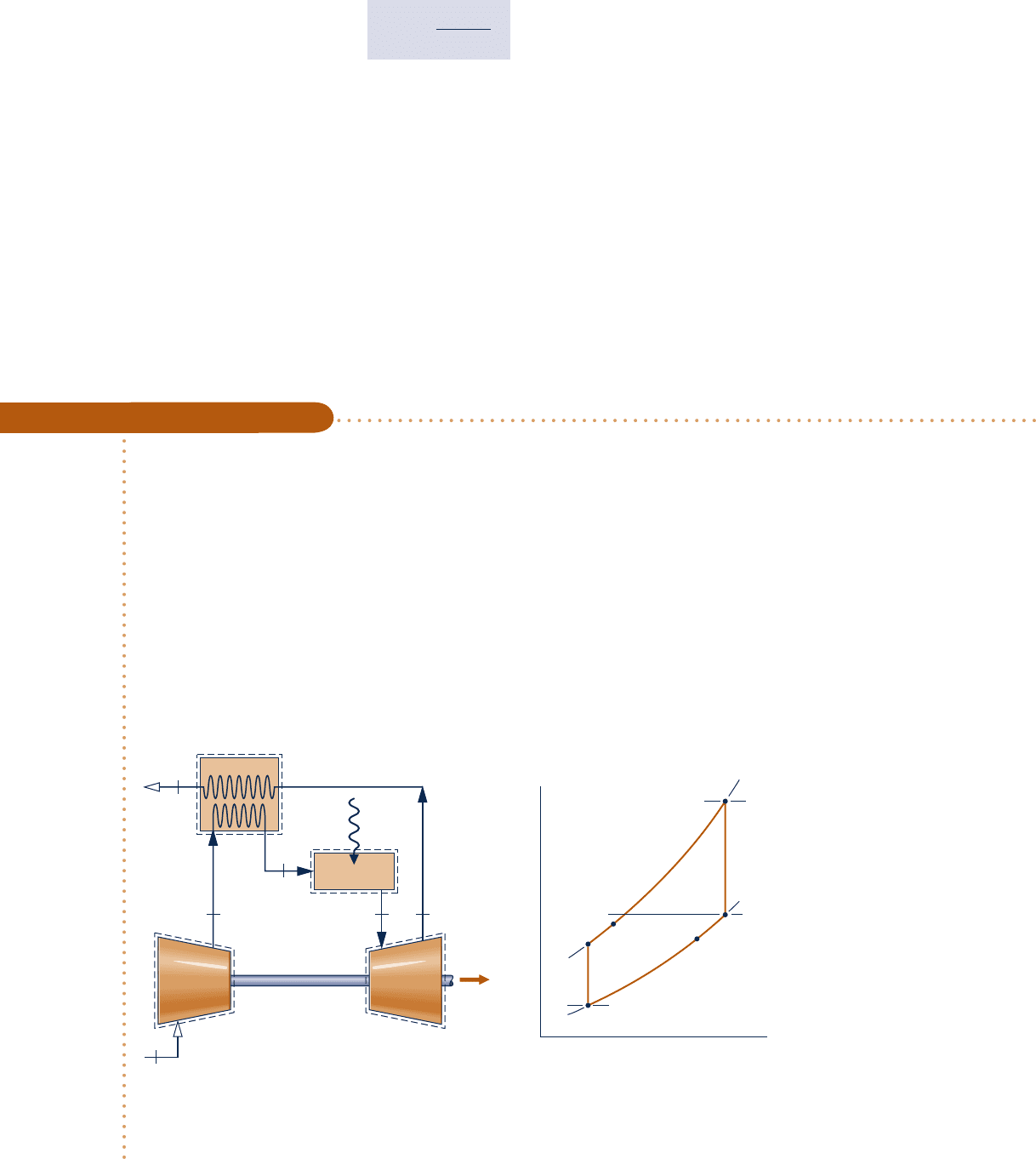
regenerator from such an ideal regenerator. The regenerator effectiveness is defined
as the ratio of the actual enthalpy increase of the air flowing through the compressor
side of the regenerator to the maximum theoretical enthalpy increase. That is,
h
reg
5
h
x
2 h
2
h
4
2 h
2
(9.27)
As heat transfer approaches reversibility, h
x
approaches h
4
and h
reg
tends to unity
(100%).
In practice, regenerator effectiveness values typically range from 60 to 80%, and
thus the temperature T
x
of the air exiting on the compressor side of the regenerator
is normally well below the turbine exhaust temperature. To increase the effectiveness
above this range would require greater heat transfer area, resulting in equipment
costs that might cancel any advantage due to fuel savings. Moreover, the greater heat
transfer area that would be required for a larger effectiveness can result in a signifi-
cant frictional pressure drop for flow through the regenerator, thereby affecting over-
all performance. The decision to add a regenerator is influenced by considerations
such as these, and the final decision is primarily an economic one.
In Example 9.7, we analyze an air-standard Brayton cycle with regeneration and
explore the effect on thermal efficiency as the regenerator effectiveness varies.
regenerator effectiveness
9.7 Regenerative Gas Turbines 523
Evaluating Thermal Efficiency of a Brayton Cycle with Regeneration
c c c c EXAMPLE 9.7 c
A regenerator is incorporated in the cycle of Example 9.4. (a) Determine the thermal efficiency for a regenerator
effectiveness of 80%. (b) Plot the thermal efficiency versus regenerator effectiveness ranging from 0 to 80%.
SOLUTION
Known:
A regenerative gas turbine operates with air as the working fluid. The compressor inlet state, turbine
inlet temperature, and compressor pressure ratio are known.
Find: For a regenerator effectiveness of 80%, determine the thermal efficiency. Also plot the thermal efficiency
versus the regenerator effectiveness ranging from 0 to 80%.
Schematic and Given Data:
Fig. E9.7a
Combustor
1
x
x
234
y
y
TurbineCompressor
Q
·
in
η
reg
=
80%
W
·
cycle
Regenerator
T
3
= 1400 K
T
1
= 300 K
p
1
= 100 kPa
T
s
1
2
3
4
T
1
= 300 K
p = 1000 kPa
p = 100 kPa
T
3
= 1400 K
c09GasPowerSystems.indd Page 523 7/19/10 9:50:30 AM users-133 c09GasPowerSystems.indd Page 523 7/19/10 9:50:30 AM users-133 /Users/users-133/Desktop/Ramakant_04.05.09/WB00113_R1:JWCL170/New/Users/users-133/Desktop/Ramakant_04.05.09/WB00113_R1:JWCL170/New

524 Chapter 9 Gas Power Systems
Engineering Model:
1.
Each component is analyzed as a control volume at steady state. The control volumes are shown on the
accompanying sketch by dashed lines.
2. The compressor and turbine processes are isentropic.
3. There are no pressure drops for flow through the heat exchangers.
4. The regenerator effectiveness is 80% in part (a).
5. Kinetic and potential energy effects are negligible.
6. The working fluid is air modeled as an ideal gas.
Analysis:
(a)
The specific enthalpy values at the numbered states on the T–s diagram are the same as those in Example
9.4: h
1
5 300.19 kJ/kg, h
2
5 579.9 kJ/kg, h
3
5 1515.4 kJ/kg, h
4
5 808.5 kJ/kg.
To find the specific enthalpy h
x
, the regenerator effectiveness is used as follows: By definition
h
reg
5
h
x
2 h
2
h
4
2 h
2
Solving for h
x
h
x
5 h
reg
1h
4
2 h
2
21 h
2
5 10.821808.5 2 579.921 579.9 5 762.8 kJ
/
kg
With the specific enthalpy values determined above, the thermal efficiency is
➊ h 5
1W
#
t
/
m
#
22 1W
#
c
/
m
#
2
1Q
#
in
/
m
#
2
5
1h
3
2 h
4
22 1h
2
2 h
1
2
1h
3
2 h
x
2
5
11515.4 2 808.522 1579.9 2 300.1
92
11515.4 2 762.82
➋ 5 0.568 156.8%2
(b) The IT code for the solution follows, where h
reg
is denoted as etareg, h is eta, W
#
comp
/
m
#
is Wcomp, and so on.
// Fix the states
T1 = 300//K
p1 = 100//kPa
h1 = h_T(“Air”, T1)
s1 = s_TP(“Air”, T1, p1)
p2 = 1000//kPa
s2 = s_TP(“Air”, T2, p2)
s2 = s1
h2 = h_T(“Air”, T2)
T3 = 1400//K
p3 = p2
h3 = h_T(“Air”, T3)
s3 = s_TP(“Air”, T3, p3)
p4 = p1
s4 = s_TP(“Air”, T4, p4)
s4 = s3
h4 = h_T(“Air”, T4)
etareg = 0.8
hx = etareg*(h4 – h2) + h2
// Thermal efficiency
Wcomp = h2 – h1
c09GasPowerSystems.indd Page 524 7/19/10 9:50:32 AM users-133 c09GasPowerSystems.indd Page 524 7/19/10 9:50:32 AM users-133 /Users/users-133/Desktop/Ramakant_04.05.09/WB00113_R1:JWCL170/New/Users/users-133/Desktop/Ramakant_04.05.09/WB00113_R1:JWCL170/New
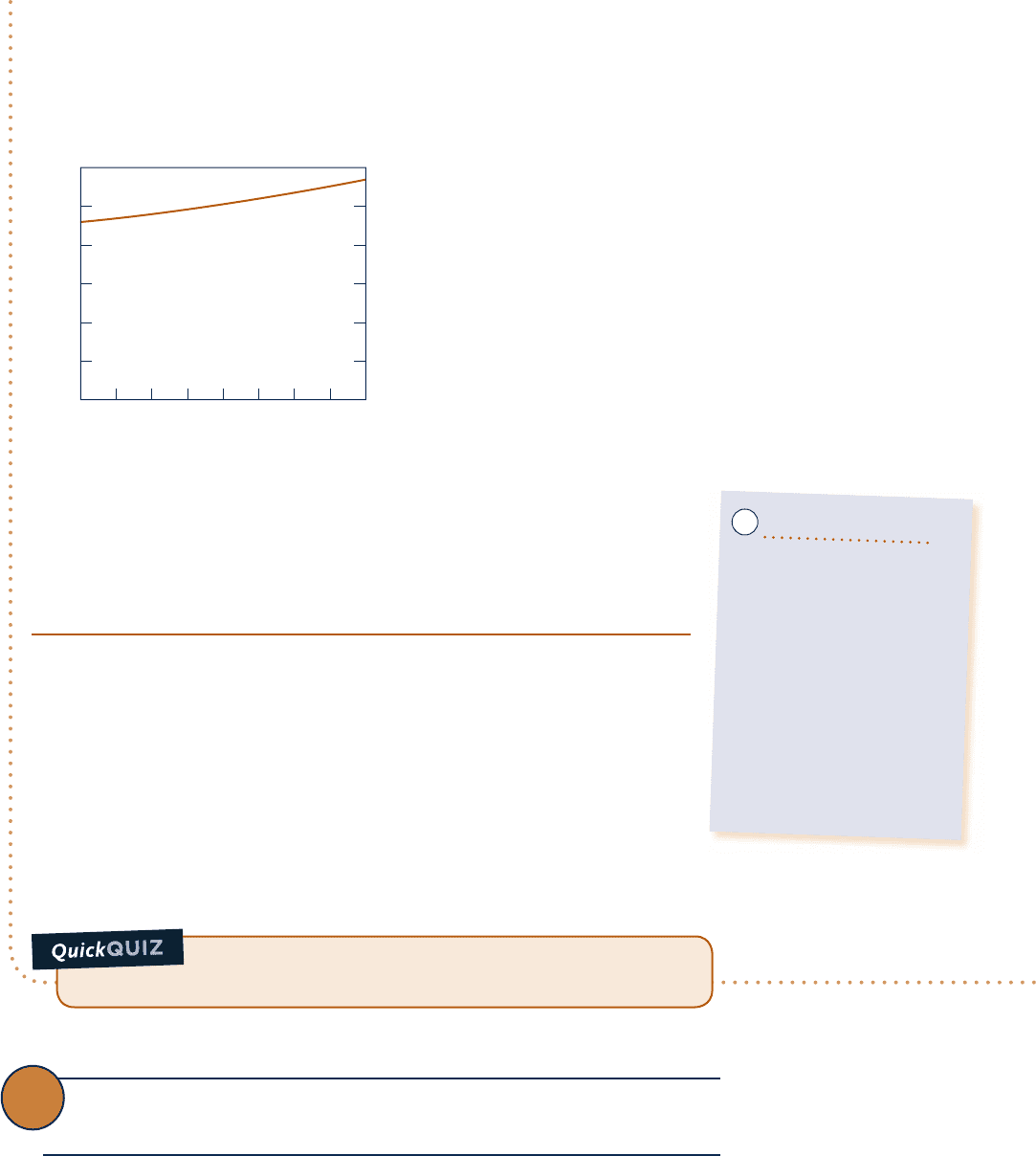
Wturb = h3 – h4
Qin = h3 – hx
eta = (Wturb – Wcomp) / Qin
Using the Explore button, sweep etareg from 0 to 0.8 in steps of 0.01. Then, using the Graph button, obtain the
following plot:
What would be the thermal efficiency if the regenerator effec-
tiveness were 100%? Ans. 60.4%.
➌ From the computer data, we see that the cycle thermal efficiency increases
from 0.456, which agrees closely with the result of Example 9.4 (no regen-
erator), to 0.567 for a regenerator effectiveness of 80%, which agrees closely
with the result of part (a). This trend is also seen in the accompanying graph.
Regenerator effectiveness is seen to have a significant effect on cycle ther-
mal efficiency.
➊ The values for work per unit of mass flow of the compressor and turbine
are unchanged by the addition of the regenerator. Thus, the back work ratio
and net work output are not affected by this modification.
➋ Comparing the present thermal efficiency value with the one determined
in Example 9.4, it should be evident that the thermal efficiency can be
increased significantly by means of regeneration.
➌ The regenerator allows improved fuel utilization to be achieved by transfer-
ring a portion of the exergy in the hot turbine exhaust gas to the cooler air
flowing on the other side of the regenerator.
Ability to…
❑
sketch the schematic of the
regenerative gas turbine and
the T–s diagram for the
corresponding air-standard
cycle.
❑
evaluate temperatures and
pressures at each principal
state and retrieve necessary
property data.
❑
calculate the thermal
efficiency.
✓
Skills Developed
9.8 Regenerative Gas Turbines with
Reheat and Intercooling
Two modifications of the basic gas turbine that increase the net work developed are
multistage expansion with reheat and multistage compression with intercooling. When
used in conjunction with regeneration, these modifications can result in substantial
increases in thermal efficiency. The concepts of reheat and intercooling are introduced
in this section.
9.8 Regenerative Gas Turbines with Reheat and Intercooling 525
Fig. E9.7b
0
0.1 0.3 0.5 0.70 0.2 0.4 0.6 0.8
Regenerator effectiveness
Thermal efficiency
0.1
0.2
0.3
0.4
0.5
0.6
c09GasPowerSystems.indd Page 525 7/19/10 9:50:34 AM users-133 c09GasPowerSystems.indd Page 525 7/19/10 9:50:34 AM users-133 /Users/users-133/Desktop/Ramakant_04.05.09/WB00113_R1:JWCL170/New/Users/users-133/Desktop/Ramakant_04.05.09/WB00113_R1:JWCL170/New
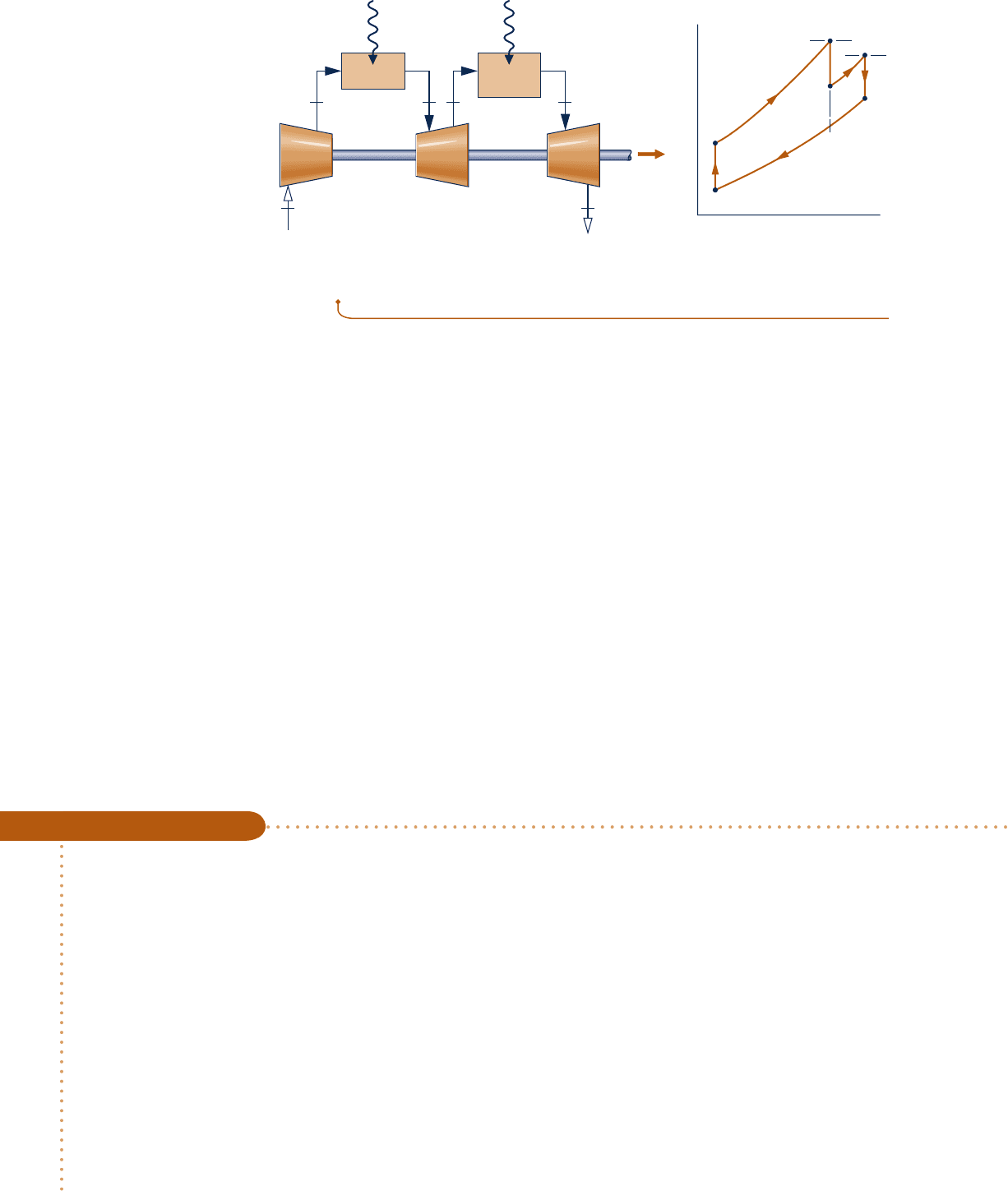
526 Chapter 9 Gas Power Systems
9.8.1
Gas Turbines with Reheat
For metallurgical reasons, the temperature of the gaseous combustion products enter-
ing the turbine must be limited. This temperature can be controlled by providing air
in excess of the amount required to burn the fuel in the combustor (see Chap. 13).
As a consequence, the gases exiting the combustor contain sufficient air to support
the combustion of additional fuel. Some gas turbine power plants take advantage of
the excess air by means of a multistage turbine with a reheat combustor between the
stages. With this arrangement the net work per unit of mass flow can be increased.
Let us consider reheat from the vantage point of an air-standard analysis.
The basic features of a two-stage gas turbine with reheat are brought out by con-
sidering an ideal air-standard Brayton cycle modified as shown in Fig. 9.16. After
expansion from state 3 to state a in the first turbine, the gas is reheated at constant
pressure from state a to state b. The expansion is then completed in the second tur-
bine from state b to state 4. The ideal Brayton cycle without reheat, 1–2–3–49–1, is
shown on the same T–s diagram for comparison. Because lines of constant pressure
on a T–s diagram diverge slightly with increasing entropy, the total work of the two-
stage turbine is greater than that of a single expansion from state 3 to state 49. Thus,
the net work for the reheat cycle is greater than that of the cycle without reheat.
Despite the increase in net work with reheat, the cycle thermal efficiency would not
necessarily increase because a greater total heat addition would be required. How-
ever, the temperature at the exit of the turbine is higher with reheat than without
reheat, so the potential for regeneration is enhanced.
When reheat and regeneration are used together, the thermal efficiency can
increase significantly. The following example provides an illustration.
reheat
c c c c EXAMPLE 9.8 c
Determining Thermal Efficiency of a Brayton Cycle
with Reheat and Regeneration
Consider a modification of the cycle of Example 9.4 involving reheat and regeneration. Air enters the compres-
sor at 100 kPa, 300 K and is compressed to 1000 kPa. The temperature at the inlet to the first turbine stage is
1400 K. The expansion takes place isentropically in two stages, with reheat to 1400 K between the stages at a
constant pressure of 300 kPa. A regenerator having an effectiveness of 100% is also incorporated in the cycle.
Determine the thermal efficiency.
SOLUTION
Known:
An ideal air-standard gas turbine cycle operates with reheat and regeneration. Temperatures and pres-
sures at principal states are specified.
Fig. 9.16
Ideal gas turbine with reheat.
Reheat
combustor
Turbine
stage 2
Q
·
in
W
·
cycle
Q
·
in
Combustor
Turbine
stage 1
Compressor
T
s
3
b
a
4
4′
1
2
a b
41
32
c09GasPowerSystems.indd Page 526 7/20/10 7:29:06 AM users-133 c09GasPowerSystems.indd Page 526 7/20/10 7:29:06 AM users-133 /Users/users-133/Desktop/Ramakant_04.05.09/WB00113_R1:JWCL170/New/Users/users-133/Desktop/Ramakant_04.05.09/WB00113_R1:JWCL170/New
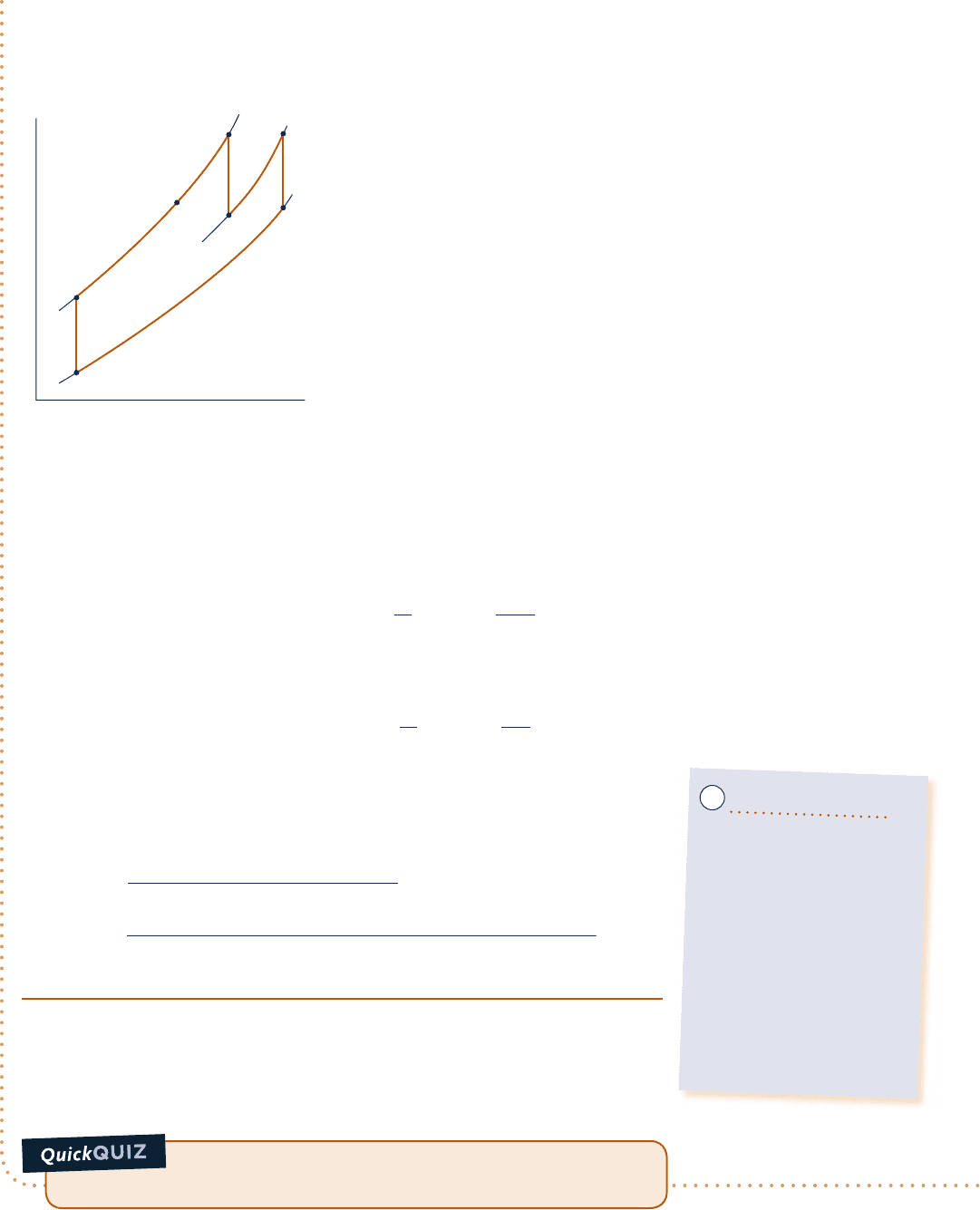
9.8 Regenerative Gas Turbines with Reheat and Intercooling 527
Find: Determine the thermal efficiency.
Schematic and Given Data:
What percentage of the total heat addition occurs in the reheat
process? Ans. 52%.
Analysis: We begin by determining the specific enthalpies at each principal state of the cycle. States 1, 2, and 3
are the same as in Example 9.4: h
1
5 300.19 kJ/kg, h
2
5 579.9 kJ/kg, h
3
5 1515.4 kJ/kg. The temperature at state
b is the same as at state 3, so h
b
5 h
3
.
Since the first turbine process is isentropic, the enthalpy at state a can be determined using p
r
data from Table
A-22 and the relationship
p
ra
5 p
r3
p
a
p
3
5 1450.52
300
1000
5 135.15
Interpolating in Table A-22, we get h
a
5 1095.9 kJ/kg.
The second turbine process is also isentropic, so the enthalpy at state 4 can be determined similarly. Thus
p
r4
5 p
rb
p
4
p
b
5 1450.52
100
300
5 150.17
Interpolating in Table A-22, we obtain h
4
5 1127.6 kJ/kg. Since the regenerator
effectiveness is 100%, h
x
5 h
4
5 1127.6 kJ/kg.
The thermal efficiency calculation must take into account the compressor work,
the work of each turbine, and the total heat added. Thus, on a unit mass basis
h 5
1h
3
2 h
a
21 1h
b
2 h
4
22 1h
2
2 h
1
2
1h
3
2 h
x
21 1h
b
2 h
a
2
5
11515.4 2 1095.921 11515.4 2 1127.622 1579.9 2 300.19
2
11515.4 2 1127.621 11515.4 2 1095.92
➊ 5 0.654 165.4%2
➊ Comparing the present value with the thermal efficiency determined in part
(a) of Example 9.4, we can conclude that the use of reheat coupled with
regeneration can result in a substantial increase in thermal efficiency.
Ability to…
❑
sketch the schematic of the
regenerative gas turbine with
reheat and the T–s diagram
for the corresponding
air-standard cycle.
❑
evaluate temperatures and
pressures at each principal
state and retrieve necessary
property data.
❑
calculate the thermal
efficiency.
✓
Skills Developed
Engineering Model:
1.
Each component of the power plant is analyzed as a control
volume at steady state.
2. The compressor and turbine processes are isentropic.
3. There are no pressure drops for flow through the heat exchangers.
4. The regenerator effectiveness is 100%.
5. Kinetic and potential energy effects are negligible.
6. The working fluid is air modeled as an ideal gas.
Fig. E9.8
T
s
3
b
a
x
4
1
2
Regenerator
exit
T
1
= 300 K
p = 1000 kPa
p = 100 kPa
p = 300 kPa
T
3
= 1400 K
c09GasPowerSystems.indd Page 527 7/19/10 9:50:38 AM users-133 c09GasPowerSystems.indd Page 527 7/19/10 9:50:38 AM users-133 /Users/users-133/Desktop/Ramakant_04.05.09/WB00113_R1:JWCL170/New/Users/users-133/Desktop/Ramakant_04.05.09/WB00113_R1:JWCL170/New

528 Chapter 9 Gas Power Systems
9.8.2
Compression with Intercooling
The net work output of a gas turbine also can be increased by reducing
the compressor work input. This can be accomplished by means of mul-
tistage compression with intercooling. The present discussion provides an
introduction to this subject.
Let us first consider the work input to compressors at steady state,
assuming that irreversibilities are absent and changes in kinetic and
potential energy from inlet to exit are negligible. The p–y diagram of Fig.
9.17 shows two alternative compression paths from a specified state 1 to
a specified final pressure p
2
. Path 1–29 is for an adiabatic compression.
Path 1–2 corresponds to a compression with heat transfer from the work-
ing fluid to the surroundings. The area to the left of each curve equals
the magnitude of the work per unit mass of the respective process (see
Sec. 6.13.2). The smaller area to the left of Process 1–2 indicates that the
work of this process is less than for the adiabatic compression from 1 to
29. This suggests that cooling a gas during compression is advantageous
in terms of the work-input requirement.
Although cooling a gas as it is compressed would reduce the work, a
heat transfer rate high enough to effect a significant reduction in work is
difficult to achieve in practice. A practical alternative is to separate the work and
heat interactions into separate processes by letting compression take place in stages
with heat exchangers, called intercoolers, cooling the gas between stages. Figure 9.18
illustrates a two-stage compressor with an intercooler. The accompanying p–y and
T–s diagrams show the states for internally reversible processes:
c Process 1–c is an isentropic compression from state 1 to state c where the pressure
is p
i
.
c Process c–d is constant-pressure cooling from temperature T
c
to T
d
.
c Process d–2 is an isentropic compression to state 2.
intercooler
Fig. 9.17 Internally reversible compression
processes between two fixed pressures.
p
v
2
1
Adiabatic compression
2
′
Compression with cooling
int
rev
=
∫
vdp
W
·
c
___
m
·
2
1
p
2
p
1
T
1
Fig. 9.18 Two-stage
compression with intercooling.
p
v
T
s
22′
2′
2
d
c
a
b
c
1
1
p
i
p
i
p
2
p
1
s = c
T = c
c
d
Compressor
stage 1
Compressor
stage 2
W
·
c
1
2
Intercooler
Q
·
out
d
c09GasPowerSystems.indd Page 528 7/19/10 9:50:42 AM users-133 c09GasPowerSystems.indd Page 528 7/19/10 9:50:42 AM users-133 /Users/users-133/Desktop/Ramakant_04.05.09/WB00113_R1:JWCL170/New/Users/users-133/Desktop/Ramakant_04.05.09/WB00113_R1:JWCL170/New
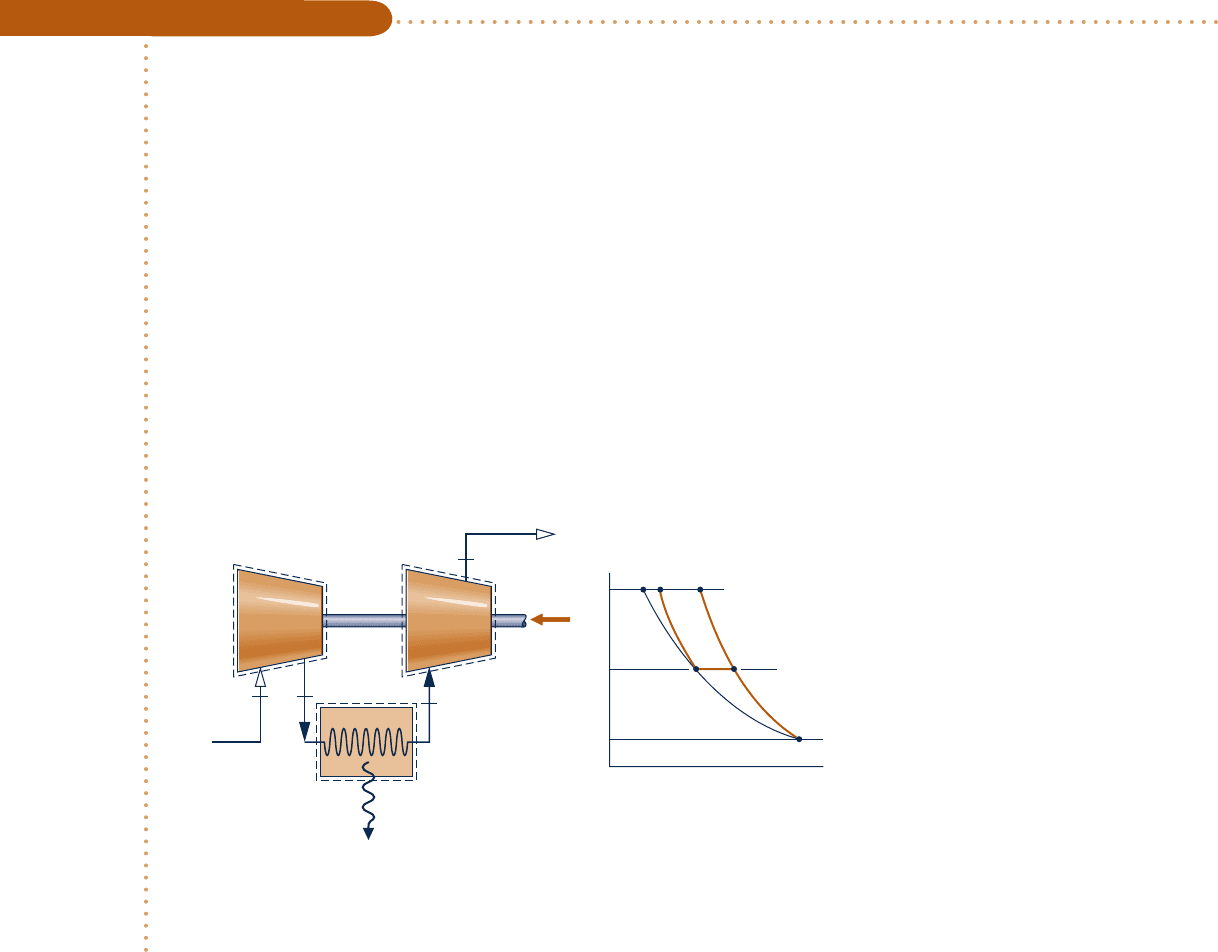
The work input per unit of mass flow is represented on the p–y diagram by shaded
area 1–c–d–2–a–b–1. Without intercooling the gas would be compressed isentropically
in a single stage from state 1 to state 29 and the work would be represented by
enclosed area 1–29–a–b–1. The crosshatched area on the p–y diagram represents the
reduction in work that would be achieved with intercooling.
Some large compressors have several stages of compression with intercooling
between stages. The determination of the number of stages and the conditions at
which to operate the various intercoolers is a problem in optimization. The use of
multistage compression with intercooling in a gas turbine power plant increases the
net work developed by reducing the compression work. By itself, though, compression
with intercooling would not necessarily increase the thermal efficiency of a gas turbine
because the temperature of the air entering the combustor would be reduced (com-
pare temperatures at states 29 and 2 on the T–s diagram of Fig. 9.18). A lower tem-
perature at the combustor inlet would require additional heat transfer to achieve the
desired turbine inlet temperature. The lower temperature at the compressor exit
enhances the potential for regeneration, however, so when intercooling is used in
conjunction with regeneration, an appreciable increase in thermal efficiency can result.
In the next example, we analyze a two-stage compressor with intercooling between
the stages. Results are compared with those for a single stage of compression.
9.8 Regenerative Gas Turbines with Reheat and Intercooling 529
Evaluating a Two-Stage Compressor with Intercooling
c c c c EXAMPLE 9.9 c
Air is compressed from 100 kPa, 300 K to 1000 kPa in a two-stage compressor with intercooling between stages.
The intercooler pressure is 300 kPa. The air is cooled back to 300 K in the intercooler before entering the sec-
ond compressor stage. Each compressor stage is isentropic. For steady-state operation and negligible changes in
kinetic and potential energy from inlet to exit, determine (a) the temperature at the exit of the second compres-
sor stage and (b) the total compressor work input per unit of mass flow. (c) Repeat for a single stage of com-
pression from the given inlet state to the final pressure.
SOLUTION
Known:
Air is compressed at steady state in a two-stage compressor with intercooling between stages. Operating
pressures and temperatures are given.
Find: Determine the temperature at the exit of the second compressor stage and the total work input per unit
of mass flow. Repeat for a single stage of compression.
Schematic and Given Data:
Fig. E9.9
p
v
23
cd
1
p
i
= 300 kPa
c
d
Compressor
stage 1
Compressor
stage 2
W
·
c
1
2
Intercooler
Q
·
out
p
1
= 100 kPa
T
1
= 300 K
p
2
= 1000 kPa
T
1
= 300 K
p
1
= 100 kPa
T
d
= 300 K
p
2
= 1000 kPa
c09GasPowerSystems.indd Page 529 7/19/10 9:50:46 AM users-133 c09GasPowerSystems.indd Page 529 7/19/10 9:50:46 AM users-133 /Users/users-133/Desktop/Ramakant_04.05.09/WB00113_R1:JWCL170/New/Users/users-133/Desktop/Ramakant_04.05.09/WB00113_R1:JWCL170/New

530 Chapter 9 Gas Power Systems
Engineering Model:
1.
The compressor stages and intercooler are analyzed as control volumes at steady state. The control volumes
are shown on the accompanying sketch by dashed lines.
2. The compression processes are isentropic.
3. There is no pressure drop for flow through the intercooler.
4. Kinetic and potential energy effects are negligible.
5. The air is modeled as an ideal gas.
Analysis:
(a)
The temperature at the exit of the second compressor stage, T
2
, can be found using the following relationship
for the isentropic process d–2
p
r2
5 p
rd
p
2
p
d
With p
rd
at T
d
5 300 K from Table A-22, p
2
5 1000 kPa, and p
d
5 300 kPa,
p
r2
5 11.3862
1000
300
5 4.62
Interpolating in Table A-22, we get T
2
5 422 K and h
2
5 423.8 kJ/kg.
(b) The total compressor work input per unit of mass is the sum of the work inputs for the two stages. That is
W
#
c
m
#
5 1h
c
2 h
1
21 1h
2
2 h
d
2
From Table A-22 at T
1
5 300 K, h
1
5 300.19 kJ/kg. Since T
d
5 T
1
, h
d
5 300.19 kJ/kg. To find h
c
, use p
r
data
from Table A-22 together with p
1
5 100 kPa and p
c
5 300 kPa to write
p
rc
5 p
r1
p
c
p
1
5 11.3862
300
100
5 4.158
Interpolating in Table A-22, we obtain h
c
5 411.3 kJ/kg. Hence, the total compressor work per unit of mass is
W
#
c
m
#
5 1411.3 2 300.1921 1423.8 2 300.1925 234.7 kJ
/
kg
(c) For a single isentropic stage of compression, the exit state would be state
3 located on the accompanying p–y diagram. The temperature at this state can
be determined using
p
r3
5 p
r1
p
3
p
1
5 11.3862
1000
100
5 13.86
Interpolating in Table A-22, we get T
3
5 574 K and h
3
5 579.9 kJ/kg.
The work input for a single stage of compression is then
W
#
c
m
#
5 h
3
2 h
1
5 579.9 2 300.19 5 279.7 kJ
/
kg
This calculation confirms that a smaller work input is required with two-stage com-
pression and intercooling than with a single stage of compression. With intercooling,
however, a much lower gas temperature is achieved at the compressor exit.
In this case, what is the percentage reduction in compressor
work with two-stage compression and intercooling compared to a single
stage of compression? Ans. 16.1%.
Ability to…
❑
sketch the schematic of a
two-stage compressor with
intercooling between the
stages and the corresponding
T–s diagram.
❑
evaluate temperatures and
pressures at each principal
state and retrieve necessary
property data.
❑
apply energy and entropy
balances.
✓
Skills Developed
c09GasPowerSystems.indd Page 530 7/19/10 9:50:48 AM users-133 c09GasPowerSystems.indd Page 530 7/19/10 9:50:48 AM users-133 /Users/users-133/Desktop/Ramakant_04.05.09/WB00113_R1:JWCL170/New/Users/users-133/Desktop/Ramakant_04.05.09/WB00113_R1:JWCL170/New
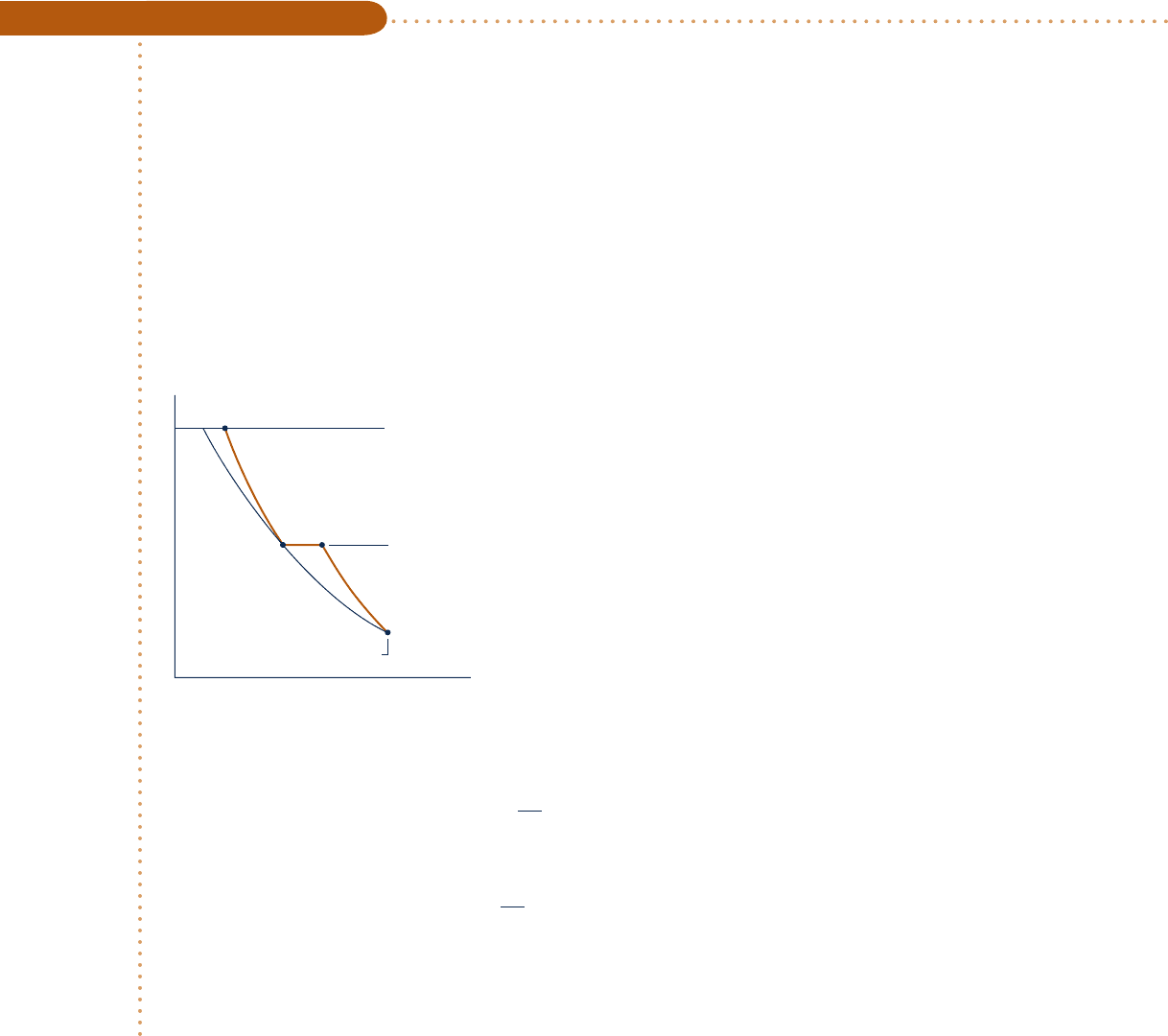
Referring again to Fig. 9.18, the size of the crosshatched area on the p–y diagram
representing the reduction in work with intercooling depends on both the tempera-
ture T
d
at the exit of the intercooler and the intercooler pressure p
i
. By properly
selecting T
d
and p
i
, the total work input to the compressor can be minimized. For
example, if the pressure p
i
is specified, the work input would decrease (crosshatched
area would increase) as the temperature T
d
approaches T
1
, the temperature at the
inlet to the compressor. For air entering the compressor from the surroundings, T
1
would be the limiting temperature that could be achieved at state d through heat
transfer with the surroundings only. Also, for a specified value of the temperature T
d
,
the pressure p
i
can be selected so that the total work input is a minimum (cross-
hatched area is a maximum).
Example 9.10 provides an illustration of the determination of the intercooler pres-
sure for minimum total work using a cold air-standard analysis.
9.8 Regenerative Gas Turbines with Reheat and Intercooling 531
Determining Intercooler Pressure for Minimum Compressor Work
c c c c EXAMPLE 9.10 c
For fixed inlet state and exit pressure, use a cold-air standard analysis to show that minimum total work input
for a two-stage compressor is required when the pressure ratio is the same across each stage. Assume steady-state
operation and the following idealizations: Each compression process is isentropic, there is no pressure drop through
the intercooler, temperature at the inlet to each compressor stage is the same, and kinetic and potential energy
effects can be ignored.
SOLUTION
Known:
A two-stage compressor with intercooling operates at steady state under specified conditions.
Find: Show that the minimum total work input is required when the pressure ratio is the same across each stage.
Schematic and Given Data:
Engineering Model:
1.
The compressor stages and intercooler are analyzed as control vol-
umes at steady state.
2. The compression processes are isentropic.
3. There is no pressure drop for flow through the intercooler.
4. The temperature at the inlet to both compressor stages is the same.
5. Kinetic and potential energy effects are negligible.
6. The working fluid is air modeled as an ideal gas.
7. The specific heat c
p
and thus the specific heat ratio k are constant.
Analysis: The total compressor work input per unit of mass flow is
W
#
c
m
#
5 1h
c
2 h
1
21 1h
2
2 h
d
2
Since c
p
is constant
W
#
c
m
#
5 c
p
1T
c
2 T
1
21 c
p
1T
2
2 T
d
2
Fig. E9.10
p
v
2
c
d
1
p
i
variable
Compressor inlet state specified
s = c
s = c
T =
c
p
2
specified
c09GasPowerSystems.indd Page 531 7/19/10 9:50:49 AM users-133 c09GasPowerSystems.indd Page 531 7/19/10 9:50:49 AM users-133 /Users/users-133/Desktop/Ramakant_04.05.09/WB00113_R1:JWCL170/New/Users/users-133/Desktop/Ramakant_04.05.09/WB00113_R1:JWCL170/New

532 Chapter 9 Gas Power Systems
With T
d
5 T
1
(assumption 4), this becomes on rearrangement
W
#
c
m
#
5 c
p
T
1
a
T
c
T
1
1
T
2
T
1
2 2b
Since the compression processes are isentropic and the specific heat ratio k is constant, the pressure and
temperature ratios across the compressor stages are related, respectively, by
T
c
T
1
5 a
p
i
p
1
b
1k212
/
k
and
T
2
T
d
5 a
p
2
p
i
b
1k212
/
k
In the second of these equations, T
d
5 T
1
by assumption 4.
Collecting results
W
#
c
m
#
5 c
p
T
1
ca
p
i
p
1
b
1k212
/
k
1 a
p
2
p
i
b
1k212
/
k
2 2 d
Hence, for specified values of T
1
, p
1
, p
2
, and c
p
, the value of the total compressor work input varies with the
intercooler pressure only. To determine the pressure p
i
that minimizes the total work, form the derivative
01W
#
c
/
m
#
2
0p
i
5
0
0p
i
ec
p
T
1
ca
p
i
p
1
b
1k212
/
k
1 a
p
2
p
i
b
1k212
/
k
2 2 df
5 c
p
T
1
a
k 2 1
k
bca
p
i
p
1
b
21
/
k
a
1
p
1
b1 a
p
2
p
i
b
21
/
k
a2
p
2
p
2
i
bd
5 c
p
T
1
a
k 2 1
k
b
1
p
i
ca
p
i
p
1
b
1k212
/
k
2 a
p
2
p
i
b
1k212
/
k
d
When the partial derivative is set to zero, the desired relationship is obtained
➊
p
i
p
1
5
p
2
p
i
By checking the sign of the second derivative, it can be verified that the total
compressor work is a minimum.
➊ This relationship is for a two-stage compressor. Appropriate relations can be
obtained similarly for multistage compressors.
Air enters an ideal two-stage compressor with intercooling at
100 kPa. The overall compressor pressure ratio is 12. What pressure, in
bar, would minimize the total work input required? Ans. 3.464 bar.
Ability to…
❑
complete the detailed
derivation of a thermody-
namic expression.
❑
use calculus to minimize a
function.
✓
Skills Developed
9.8.3
Reheat and Intercooling
Reheat between turbine stages and intercooling between compressor stages provide
two important advantages: The net work output is increased, and the potential for
regeneration is enhanced. Accordingly, when reheat and intercooling are used
together with regeneration, a substantial improvement in performance can be real-
ized. One arrangement incorporating reheat, intercooling, and regeneration is shown
in Fig. 9.19. This gas turbine has two stages of compression and two turbine stages. The
accompanying T–s diagram is drawn to indicate irreversibilities in the compressor
c09GasPowerSystems.indd Page 532 7/19/10 9:50:52 AM users-133 c09GasPowerSystems.indd Page 532 7/19/10 9:50:52 AM users-133 /Users/users-133/Desktop/Ramakant_04.05.09/WB00113_R1:JWCL170/New/Users/users-133/Desktop/Ramakant_04.05.09/WB00113_R1:JWCL170/New
